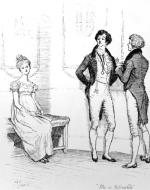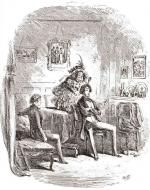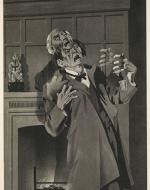Created by Aymon Langlois on Tue, 11/02/2021 - 14:22
Description:
Stigma, according to Heather Love, in her essay of the same name, is that “disapproval and disadvantage that attach[es] to people who are seen as different” (173). It metastasizes perceptions of impairment, transforming it (i.e. “body-mind” limitations) into disability (i.e. what elsewhere I have called society’s “myriad barriers to inclusivity”). Love details how “[o]nce a person is stigmatized, other qualities tend to be interpreted through the lens of this trait” (Clare xvi; “Towards A More Social Social Model”; 175). In this exhibit, I am interested in what I have termed “externalizing stigma,” that which interprets outer qualities “through the lens” of inner ones, thus externalizing difference. Accordingly, characters representing minority identities, experienced inwardly—such as Jane Austen’s autistic Mr. Darcy and Stevenson’s decadent Mr Hyde—at the beginning of the century retain an outward semblance of normalcy and, by the end, are stigmatized (Love 175)
Hugh Thomson, "She is Tolerable," from Jane Austen's Pride and Prejudice, 1813 (1894 Peacock Edition).
Mr. Darcy, in Austen’s Pride and Prejudice—a Regency novel, in the truest sense of the term—is arguably coded as autistic: after declaring that Lizzy “is tolerable; but not handsome enough to tempt me,” he reveals to her that “ 'I certainly have not the talent which some people possess of conversing easily with those I have never seen before. I cannot catch their tone of conversation, or appear interested in their concerns, as I often see done'” (7, 119). Still public perception regarding his physique is unchanged: his features are “handsome” and, now, they are “perfectly good” (Austen 6, 172).
Norman Page (University of Nottingham) writes in The Language of Jane Austen that “The reader of [Jane Austen’s] novels […] soon becomes aware of, negatively, the conspicuous absence of words referring to […] the world of shape […] and, on the positive side, of the recurrence of a relatively small number of frequently-used words, mainly epithets and abstract nouns indicating personal qualities—qualities, that is, of character and temperament rather than outward appearance” (54-55). I argue that the aforementioned coding is so decipherable for reason of Austen’s and, by extension, the Regency’s investment in temperament and that—because their inattention to “the world of shape […] outward appearance” rendered stigma inoperable, effectively nonexistent—Mr. Darcy retains his societal status as handsome as Thomson, in keeping with this Regency phenomenon some 80 years after the Regency, depicts him in the above illustration.
Hablot Knight Browne, Phiz’s "I Make the Acquaintance of Miss Mowcher," from Charles Dickens's David Copperfield, 1850.
Mid-century novels like Charles Dickens's The Personal History, Adventures, Experience and Observation of David Copperfield the Younger of Blunderstone Rookery (Which He Never Meant to Publish on Any Account) mark the growing visibility of physical impairment in Victorian England in characters such as the "pursy dwarf," Miss Mowcher. In the above image, Phiz follows Dickens's lead, stigmatizing her embodiment, caricaturing her short stature by placing her on a table "as if [...] a stage" (citation). Others like Elizabeth Gaskell's Mary Barton: A Tale of Manchester Life (1848)—in which John Barton remarks of Jane Wilson (of whom no illustrations exist), "She cotched her side again a wheel. It were afore wheels were boxed up [...] poor wench, all pale and limping"—perhaps more importantly contextualize this growing visibility as, often, a product of industrialization and industrial accidents (81).
S. G. Hulme Beaman, "The Features Seemed to Melt and Alter," from Robert Louis Stevenson's The Strange Case of Dr Jekyll and Mr Hyde, 1886 (1930 edition).
Mr Hyde, of Stevenson’s The Strange Case of Dr Jekyll and Mr Hyde, engages frequently in what the late Victorians would have considered decadent, “undignified” behavior: he “trampled calmly over [a] child’s body and left her screaming on the ground” (59, 7). In this way—in his temporal, cultural context—Hyde occupies a minority identity. And yet, unlike the experience of Austen's Mr. Darcy, stigma by the later century holds potent consequences for Mr Hyde’s corporeality. As I detail in my paper entitled “Covert Aestheticism: Disability and ‘Narrative Prosthesis’ in Stevenson’s The Strange Case of Dr Jekyll and Mr Hyde,” "contrary to public opinion, seemingly ignorant of the evidence presented by the text, Hyde is beautiful. When proverbially placed side by side with Dr. Henry Jekyll, a paragon of virtue, both physically and otherwise, Hyde is 'younger, lighter, happier in body' (57). And yet […] Hyde’s decadent revelry makes such an impression on Mr. Enfield that his perception of Hyde’s body is tainted with, nay dictated by bias. Enfield sees neither youthfulness nor grace but surmises, 'There is something wrong with his appearance […] something downright detestable. I never saw a man I so disliked and yet I scarce know why. He must be deformed somewhere; he gives a strong feeling of deformity, although I couldn’t specify the point' (The Strange Case of Dr Jekyll and Mr Hyde 10).” Indeed Beaman’s above illustration of Hyde, “The Features Seemed to Melt and Alter”—with its missing teeth, bony hands, and gaunt, emaciated visage—evinces an adherence to such stigmatic perceptions of Mr Hyde’s body (emphasis added).
I argue that it was the growing visibility at mid-century, mentioned above, that supplied the fin de siècle with the language of a “world of shape […] outward appearance,” previously nonexistent, which made physical impairment ultimately inevitable in the late Victorian novel.
Works Cited
Austen, Jane. Pride and Prejudice. Thrift ed., Dover, 1995.
Clare, Eli. Brilliant Imperfection: Grappling with Cure. Duke University Press, 2017.
Gaskell, Elizabeth. Mary Barton: A Tale of Manchester Life. Edited by Thomas Recchio, W.W. Norton & Company, Incorporated, 2008.
Langlois, Aymon E. “Covert Aestheticism: Disability and ‘Narrative Prosthesis’ in Stevenson’s The Strange Case of Dr Jekyll and Mr Hyde.” Wordgathering: A Journal of Disability Poetry and Literature 15.2 (2021).
Langlois, Aymon E. “Towards a More Social Social Model.” Skidmore College.
Love, Heather. “Stigma.” Keywords for Disability Studies. Edited by Rachel Adams, et al., New York University Press, 2015, pp. 173–176.
Page, Norman. The Language of Jane Austen. Basil Blackwell, 1972.
Stevenson, Robert Louis. The Strange Case of Dr Jekyll and Mr Hyde and Other Tales of Terror. Edited by Robert Mighall, Penguin Group, 2002.
Works Referenced
Dickens, Charles. The Personal History, Adventures, Experience and Observation of David Copperfield the Younger of Blunderstone Rookery (Which He Never Meant to Publish on Any Account). Edited by Jerome H. Buckley, W. W. Norton & Company, Incorporated, 1990.
Copyright:
Associated Place(s)
Part of Group:
Featured in Exhibit:
Artist:
- Hugh Thomson
- Phiz (Hablot K. Browne)
- S. G. Hulme Beaman




